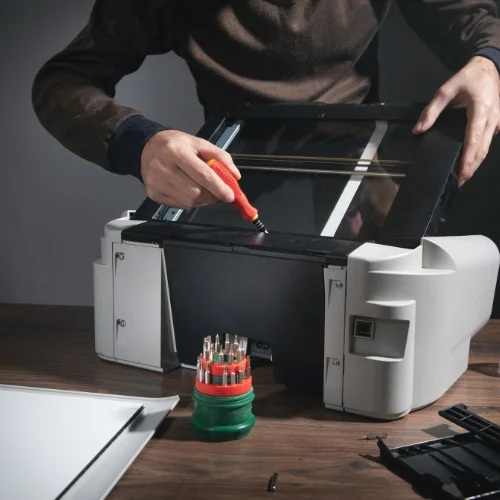Printer Repair: A Complete Guide to Troubleshooting and Maintenance
Printers are essential tools in homes, offices, and businesses, but like any machine, they are prone to malfunctions over time. Whether it’s a paper jam, poor print quality, or connectivity issues, understanding how to identify and fix common printer problems can save time and money. This blog will guide you through the essentials of printer repair, from basic troubleshooting to preventative maintenance

Common Printer Problems and How to Fix Them
1. Paper Jams
Cause: Misaligned paper, overloaded trays, or debris in the paper path.
Solution:
Turn off the printer.
Gently remove the jammed paper from the feed tray or output tray.
Check for small bits of torn paper or foreign objects.
Ensure the paper is properly aligned in the tray before restarting.
2. Printer Not Responding
Cause: Connectivity issues, outdated drivers, or power supply problems.
Solution:
Check power and USB cables or wireless connections.
Restart both the printer and the computer.
Update or reinstall the printer driver.
For network printers, ensure it’s on the same Wi-Fi network as your computer.
3. Low Print Quality
Symptoms: Streaks, faded print, smudges, or incorrect colors.
Solution:
Clean the printhead or nozzles using the printer’s utility software.
Replace low or empty ink/toner cartridges.
Use high-quality paper and genuine printer supplies.
Align the printer heads regularly.
4. Printer Offline or Not Found
Cause: Network configuration errors or driver issues.
Solution:
Restart the router and printer.
Reconnect to the wireless network manually.
Reinstall printer drivers.
Set the printer as the default in your computer’s settings.
5. Slow Printing
Cause: High-resolution settings, complex graphics, or outdated firmware.
Solution:
Reduce print quality settings for regular documents.
Upgrade firmware and drivers.
Print in draft mode if high quality isn’t required.
Preventative Maintenance Tips
Regular Cleaning: Wipe the exterior and interior (carefully) to prevent dust buildup.
Use the Printer Regularly: This helps avoid ink clogs in inkjet models.
Keep Firmware Updated: Manufacturers release updates to fix bugs and improve performance.
Store in a Dust-Free Environment: Especially important for open-tray printers.
Check for Worn Parts: Replace rollers, cartridges, and drums as recommended.
When to Call a Professional
While many printer issues are easy to resolve at home or in the office, some problems require expert attention. Contact a professional technician if:
The printer displays recurring error codes.
There’s internal damage or electrical issues.
Repairs require parts replacement or disassembly.
Hiring a certified repair service can extend the life of your printer and ensure it operates at peak efficiency.